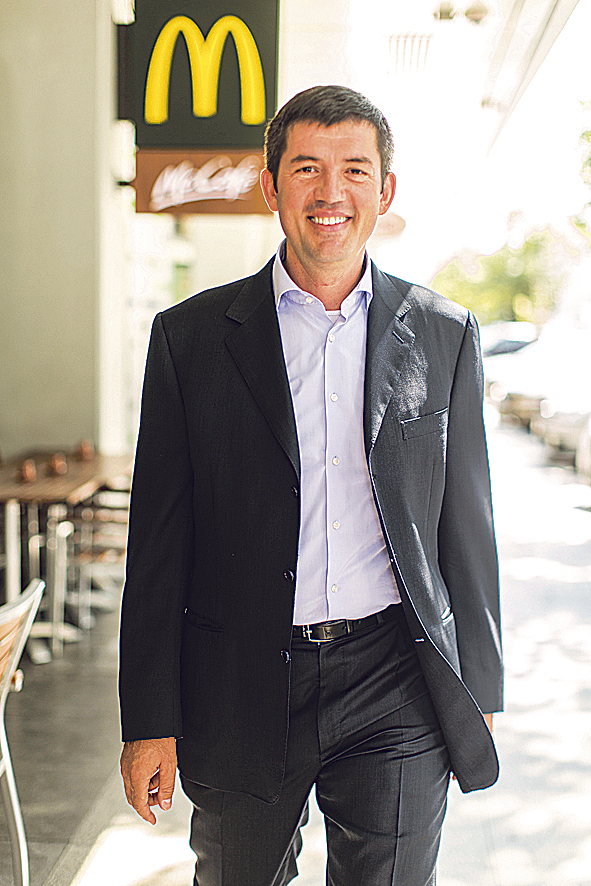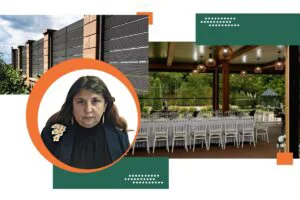Marius, a 20 years old student at the Bucharest University of Economic Studies, is a cool guy. He wears an earring and a punk spike, he works for Orange, he plays tennis twice a week and he likes to keep track of everything – “I’m always online”. Last week, Marius was having lunch at the McDonald’s restaurant in America House (Victory Square). He does it about once a week. It’s not like he is a McDonald’s fan, but he prefers the McChicken menu to almost anything else from Subway, where he only eats “a certain type of sandwich”, as he expertly explains.
He paid 15 RON (less than four euros) for the meal and he says he would pay as much for his lunch in any given working day. Marius seems the perfect customer for the fast food companies. His working day lasts up to 12 hours and he doesn’t have too much free time to go to lunch, so such restaurants are a good option. And, the most important, he could easily become a constant customer if his expectations are met. This guy, who came from Craiova to study in Bucharest, is among the six million inhabitants of Romania’s cities (those with more than 100,000 inhabitants) targeted by the big fast-food networks, such as McDonald’s, KFC, and Subway.
If one third of the six million people would buy a fast-food meal twice a week spending about five euros per meal, the networks might reach revenues of about one billion euros a year (the estimates indicate the whole market is in fact double, as they also take into account the small diners and the towns with less than 100,000 inhabitants).
Even a 10% market share from the big cities market would bring annual revenues of about 100 million euros to a national fast food network according to the above estimates. Perhaps such calculations –for sure more detailed- were made by Daniel Boaje, the CEO of McDonald’s Romania, who is currently the leader of the market, with revenues of about 94 million euros in 2013.
“Smart-food”, the new McDonald’s policy
150,000 people eat each given day in Boaje’s network of restaurants. This is the main reason why, despite the economic crisis, the company invested in opening new locations, but also in new technologies for attracting customers. “We will have soon the most modern payment solution on the Romanian retail market. (…) We are very ambitiously going towards a modern development and we have significant digital projects. Most probably at the beginning of 2015 we will launch a mobile app”, Daniel Boaje revealed. He let fall the technology became a necessity for McDonald’s. Introducing free Wi-Fi networks in the restaurants was only the first step, the manager explained, saying that his company will “shortly” reveal other “technological novelties” meant to attract to its restaurants (mostly) the youngsters and their inseparable smartphones.
In the meantime, the company keeps on expanding: “In the medium term, the plans are to come back to a rhythm of three to five new restaurants a year. However, in 2014 we are just remodeling four old units.” And if McDonald’s is already the market’s leader, Boaje’s target is to make McCafé the number one on the coffee shops market. “We have 10 McCafés right now and we are going to open four more by the end of the year – two in Bucharest and two in Pitesti and Ploiesti. My goal is to have 20 coffee shops by the end of 2015 and to become market’s leader”, Boaje said. He explained the McDonald’s restaurants which include a McCafé are visited by at least 5% more customers than before. (According to some market anonymous sources, the McDonald’s restaurants that include a McCafé, such as those from Romana Square or Unirii Square in Bucharest, have more than two million customers a year and annual revenues estimated at three-four million euros).
The race for the first place
The goal is rather audacious, taking into account McDonald’s is not the only company making investments in coffee shops. Their Starbucks conational, with local revenues of about seven million euros in 2013, also have 10 coffee shops and is “determined to double our network by the end of the year”, as Costin Gheorghiu, District Manager Starbucks Romania said.
Daniel Boaje doesn’t seem disturbed by the tight competition and says McDonald’s will keep a big and comfortable distance between it and its competitors. “We bought another plot in Timisoara and we also have advanced negotiations for other four locations that we want to buy. Two of the projects are in Bucharest. It’s unlikely to open a new restaurant in 2014, but we will start the construction works for at least one of those we are planning to open in 2015”, the McDonald’s Romania CEO said.
The company totally or partially owns over 25 of the lands on McDonald’s restaurants are built and the rented spaces have contracts for minimum 20 years. The American network have 67 restaurants in Romania (seven of them being franchised), 33 of them being McDrive units (all of the latter’s buildings are owned by the company). “All the new lands we purchased are for McDrive units, this is our strategic development orientation”, Boaje pointed out.
Opening as many Kentucky Fried Chicken drive-thru restaurants (opened 24/7 and with the possibility of ordering from inside our vehicle) is Mark Hilton’s goal. Hilton is the General Manager of the Yum! brands in Romania (KFC, Pizza Hut and Pizza Hut Delivery – PHD). The process started in 2009 through a first drive-thru KFC in Sibiu and “because there is a lot of still non used potential we decided to develop this concept on the Romanian market”, Hilton was saying in a recent interview. The investment for building a drive-thru restaurant reaches 800,000 euros, twice as much as compared to opening a regular fast-food restaurant in a mall.
In fact, the developing of drive-thru restaurants is part of a strategy that concerns all the managers of the major fast-food networks. Subway, which entered the market in 2012, also opened a first drive-thru restaurant in Sibiu. In only two years, they opened 20 restaurants all over Romania and they don’t plan to stop, as their goal is to arrive to 40 units. The economic crisis only affected the local business of Burger King. After three years in Romania, the Atlantic Restaurant System, the Burger King franchisor for the local market, closed all its restaurants in 2012.
Interview
Daniel Boaje: «The franchising process is stopped and it will remain like this for the next two years»
Maintaining McDonald’s on top of the fast food networks in Romania and making McCafé the leader on the Romanian coffee shop market – this is McDonald’s Romania CEO’s stated goal.
Capital: How do the McDonald’s Romania’s results look like in 2014?
Daniel Boaje: We have a much bigger growth than in 2013. We can feel a small recovery in terms of consumer confidence. There is not a clear boost, but it’s obvious Romanians spend their money in a little bit more relaxed way. I don’t believe in unpredictable developments, I don’t believe in spectacular grows. McDonald’s Romania will never have a spectacular decrease in term of financial results because the things that we do are well-thought-out. We have a profitability increment which is in line with company’s expectations and we keep on doing ambitious investments.
Capital; McDonald’s profitability tripled in 2013 as compared to the previous year. How can this be explained?
D.B.: The 2012 profit was influenced by exceptional investments on one hand and by a significant expense in changing the IT system on the other. The investments in developing our network, during the 19 years on the local market, totaled over 600 million RON, and more than a third of this sum was invested in the past three-four years. Romania is a market with a big potential and we invest accordingly.
Capital: Does McDonald’s consider transferring the network to a franchised company?
D.B.: Until now, we didn’t have any discussion regarding this subject. There were franchising requests for single restaurants, but we didn’t have any discussion regarding taking over all the 60 restaurants operated by McDonald’s Romania.
Capital: When are you going to restart the franchising process in Romania?
D.B.: McDonald’s is a franchise company, 80% of the restaurants active all over the world are franchised. And there are countries, such as Serbia, Bulgaria, Greece, and the Baltic States, where we developed under a single franchisor, which became responsible for the whole McDonald’s activity there. But in Romania things are different, the situation is somehow uncommon – most restaurants are owned by the company and there are five franchisors that operate seven restaurants, in Brasov (3), Bacau, Galati, Arad and Suceava. The franchising process is stopped for the moment. When the business evolution for McDonald’s Romania will become predictable in the long term –the shortest franchise contract was signed for 17 years- we will close new deals. Our 19 years history in Romania had its ups and downs. The evolution of the past three years is encouraging, but 2008, 2009 and 2010 are not that far away. The consumption didn’t fundamentally improve. There is still some incertitude and until it’s not cleared we’re not going to take a long-term business decision. We’ll remain on hold for a year or two.





